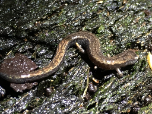Southern California Slender Salamander (B. major)
Description: Also called the Garden Slender Salamander. While Batrachoseps major is a small salamander, it is larger than most other Batrachoseps slender salamanders. Adults are 1.3–2.3 inches in length and have 17-21 costal grooves. Like other Batrachoseps, B. major has only four toes on its hind feet. Color is variable, but individuals are usually some form of gray. A key identification feature is the color of the underside, which is pale for B. major. This is the simplest method to distinguish B. major from the similar B. nigriventris where the two co-occur, although the latter is typically also much smaller and less robust.
Habitat: Native habitat for B. major includes coastal sage scrub, oak woodland, conifer forests, and, rarely, north-facing slopes of desert mountains in the Peninsular ranges. This species is also one of the few native California amphibians to adapt reasonably well to urban development, and the species occurs throughout the heavily developed Los Angeles Basin in yards and other similar non-native habitat where moisture is present.
Range: Batrachoseps major is endemic to a relatively small portion of southern California and northwestern Baja California within the California Floristic Province, ranging from the San Fernando Valley in the north south to Ensenada, with records as far south as El Rosario and the Sierra de San Pedro Mártir. It also occurs on Santa Catalina Island, the Coronado islands, and the Todos Santos islands, though it was probably introduced there. Despite its small geographic range, it is generally abundant within that range.
Found in these States:
CA
Diet: Batrachoseps major feeds on worms, insects, and other invertebrates, using its long tongue to grab prey. Swallowing prey can often take longer than 30 minutes after it has been captured by the salamander.
Reproduction: Reproduction is terrestrial. Breeding probably occurs from November to January, during the rainy season. Females lay strings of up to 10-20 eggs under stones or moist debris. Communal nesting is likely. Young develop completely in the egg and hatch fully formed. Hatchlings have been observed in January, and as late as April.
Status: Listed as Least Concern in view of its relatively wide distribution, tolerance of a broad range of habitats and presumed large population.
»» Kingdom: Animalia - Animals
»» Phylum: Chordata - Chordates
»» Subphylum: Vertebrata - Vertebrates
»» Class: Amphibia - (Amphibians)
»» Order: Caudata - Salamanders
»» Family: Plethodontidae - Lungless Salamanders
»» Genus: Batrachoseps
»» Species: B. major - Southern California Slender Salamander
This article uses material from the Wikipedia article "Garden slender salamander", which is released under the Creative Commons Attribution-Share-Alike License 3.0. Content may have been omitted from the original, but no content has been changed or extended.
|








